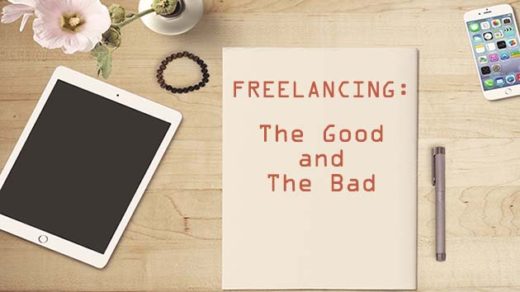I started freelancing about two years ago, and shortly after that I decided to start the process of forming a more formal business. If you have ever freelanced or worked for yourself in any way before, I don’t have to tell you how incredibly hard it can be at times. Especially when you’re just starting out. There is SO much to learn about being self-employed that at times I seriously doubted I would make it as a freelancer.
Fortunately it does get better with time, and eventually things started to click and slowly began to make sense to me. The more I read, studied, learned and actually put into practice, the more things came into focus. And the same can be true for you – if you trust yourself and do not give up too soon. You just need to give yourself the time to gain experience, because certain things don’t really make sense until you’ve been doing them for quite a while.
For me one of “those things” happens to be writing proposals.
Since I began working for myself the two hardest things for me to wrap my head around are:
- How to price my services
- How to create effective proposals and how to know what style of proposal to use in what situation
And
Two years ago I literally didn’t even know what a proposal was (not kidding. I never had to send one before). And I’m just starting to really get the hang of the whole proposal process now.
The whole concept was unfamiliar to me, because being employed at a large corporation for over 18 years, I never even had to think about proposals. I was familiar with the traditional route of getting a job: sprucing up my resume, crafting formal cover letters and filling out long, tedious application forms.
I was familiar with the traditional route of getting a job: sprucing up my resume, crafting formal cover letters and filling out long, tedious application forms.
But as a freelancer, applying to jobs (aka freelance gigs) is so different!
- there usually aren’t long applications to fill out
- the tone of your writing needs to be more casual and approachable
- clients don’t want to read about your life history, every school you went to, or every club you’ve ever belonged to
- it usually doesn’t even matter what schools you attended or even if you went to college
With the ‘traditional’ way of applying to jobs, it’s often a case where the more info you can give an employer about you the better. After all, the employer is taking on a big responsibility by hiring a new (often full time) employee. It’s a big investment for them in both time and money, so they need to do their due-diligence and really know who they are hiring.
Freelancing is different. Freelance gigs are often short-term, one-time projects. Employers aren’t usually taking on as much of a responsibility and consequently don’t usually require very extensive ‘paperwork’ from whomever they plan on hiring.
So what does that mean in terms of writing proposals as a freelancer or independent contractor?
It means you have to keep it brief.
Like 4 -7 short paragraphs at the most. Prospective employers (clients) don’t generally want to spend a lot of time reading through all the proposals they receive. Yours could be one of a hundred or more bids a client has to sort through – so keep it short, use bullet points and get to the point quickly.
Another thing to keep in mind: make the proposal about the client – not so much about you. In looking back through some of my old cover letters (that I wrote very soon after I was laid off) it makes me cringe to see how much they were all about ME. Nearly every sentence starts with “I”.
Here is a short excerpt from one of those cover letters:
I am interested in the [insert job role here] position that was posted on your job search website. I am an IT professional, with extensive experience in the insurance industry, in web development, managing web content, and managing small projects. I also have a significant amount of experience interacting with vendors.
I designed graphics and web templates, created and updated web pages using XML, CSS, HTML, and Javascript. I am a CMS (content management system) power-user. I also provided QA and regression testing services on a major corporate website … etc.
And the I’s keep going on from there… Ugh!
Instead of doing that: simply write from your audience’s perspective and briefly touch upon their project, how your skills pertain to their project and specifically what you can do to help them. Make sure to call attention to a few projects you’ve done in the past that are very relevant and are directly related to the type of project or job you’re applying for.
Your client has a ‘problem’ (the project or job) and you need to present yourself as the solution.
It’s up to you to tell them how you will solve their problem. Right in your proposal, give them a few concrete, practical and innovative suggestions for how they can solve their problem (without giving away too much for free though).
Clients aren’t really interested in too much else.
Let’s talk specifically about submitting proposals to jobs or projects on online freelancing platforms.
I only truly began to get an understanding of how to word my proposals after I became a client myself on those platforms. Until that point I was consistently submitting proposals/bids that were WAY too long, and were way too focused on myself. My proposals were at least 8-10 paragraphs and were filled with my back story and employment history.
BORING … 
(no wonder in my early days of freelancing I received so few responses…)
But after becoming a client I saw things from a totally different point of view. After posting a job on one freelancing platform and receiving multiple bids from other freelancers, it really opened my eyes; I highly recommend doing this if you are in a position to.
Like most people, I was pressed for time while looking through the proposals and found myself skimming through them, and unfortunately not reading the entirety of each proposal.
Here are the main things I took away from that experience:
- I felt most comfortable [aka took the time for] reading the proposals that were short, concise, and to the point.
- Bulleted lists were a big advantage and helped with ease of reading.
- I did not take the time to read every detail, especially for the really long proposals that were sent to me.
- If a section of the proposal sounded more generic (like a template the person was using over and over), I tended to skip over that section.
- It was a plus if the freelancer took the time to look up my name and used it. Believe it or not there were a few proposals in my inbox that started with “Dear Sir” !
- I really gravitated towards the proposals that where short and sounded like they were hand-written just for my job posting.
- Freelancers who used a friendly, casual tone in their writing seemed more genuine and interested.
Here is an example of a proposal that I’ve been sending out lately that has been quite successful.
It’s pretty short and concise and I show my interest by asking a few questions.
MORE THOUGHTS on freelance proposals:
- Clients who post jobs don’t always know what the job is worth or what to set for a price range or hourly rate. I’ve learned that you can propose a higher rate if you can bring value to the project.
- Always always always ask the client a question or 2 in your proposal or in some other way, such as through a direct message or via the questions that are sometimes included in the project-bidding form.
- Let them know you are excited about their project.
- Give them a hint of how you would solve their problem, but don’t give away too much for free!
- You should show samples of your past work, but should not do any work for the specific job you are applying to, unless you are getting paid to create a test project of some sort. I have seen these types of requests out there on freelancing platforms, where a client is asking freelancers to create wireframes or PSD mockups and layouts for their new requested website. They say something like “I want to see the design you come up with for my new website, and will choose the best one.”
I’m sorry – but to me this is a BIG red flag. I don’t know about you, but I don’t want to have to crack open Photoshop or Illustrator and do a bunch of work before even applying for a freelancing gig. Not only that – there’s also the fact that the client could literally take your layout and design ideas and start implementing them on their own (without you as part of the picture). - Just be cautious and try not to be over-eager, that’s all I’m sayin’ …
- Strive to always end your proposals with a clear CTA (call-to-action). Let the job poster know you are truly interested in their specific project and would like to schedule a short meeting to chat. Or ask them to reach out to you, let them know you are looking forward to hearing from them, etc.
- Make it easy for the prospective client to get in touch with you. Perhaps send them a link to your calendar to make it really easy (if the job platform you’re working on allows for that sort of thing).
Think long-term strategy
If you are browsing through job or project postings on any of the major freelancing platforms (Upwork, Guru, Freelancer, etc.) you may notice how many jobs stay there until the job is fairly old. I regularly see jobs that say something like “Posted 1 month ago” or “Posted 24 days ago” but do still apply to these jobs if they seem like a great match for me. In this case I assume the client has already been interviewing and has a candidate in mind, so I’ll modify my proposal just a bit.
After my opening and greeting I usually add wording like this:
I see you are looking for someone to assist you with [insert job details here] and to be available for future development. Please consider me as a candidate to assist now – or in the future if you no longer need any immediate assistance.
I have had some luck with this approach and have received offers for interviews even for jobs that were over a month old. Remember: even if an employer doesn’t choose you right at the moment, they will most likely remember you in the future when they have other jobs to post. If you come across as truly knowledgeable and interested in them, they will take note of that and keep it in the back of their mind.
In conclusion
It can be truly daunting to start out on your own and venture into freelancing. It can take A LOT of time to establish yourself and build a reputation. And it can be heartbreaking to have your proposals ignored over and over again. I’ve been there and I get it.
The key is to NOT GIVE UP even when everything is pointing in the direction of goin’ nowhere. Because that next client – or that first client – could be just around the corner. It happened for me, and it can happen for you too.
Are you struggling with writing proposals that get results? Or do you have additional advice what to include/exclude from a proposal? Drop me a comment or question below to keep the conversation going. That way we can all figure out this proposal thing. We’re all in this together!







